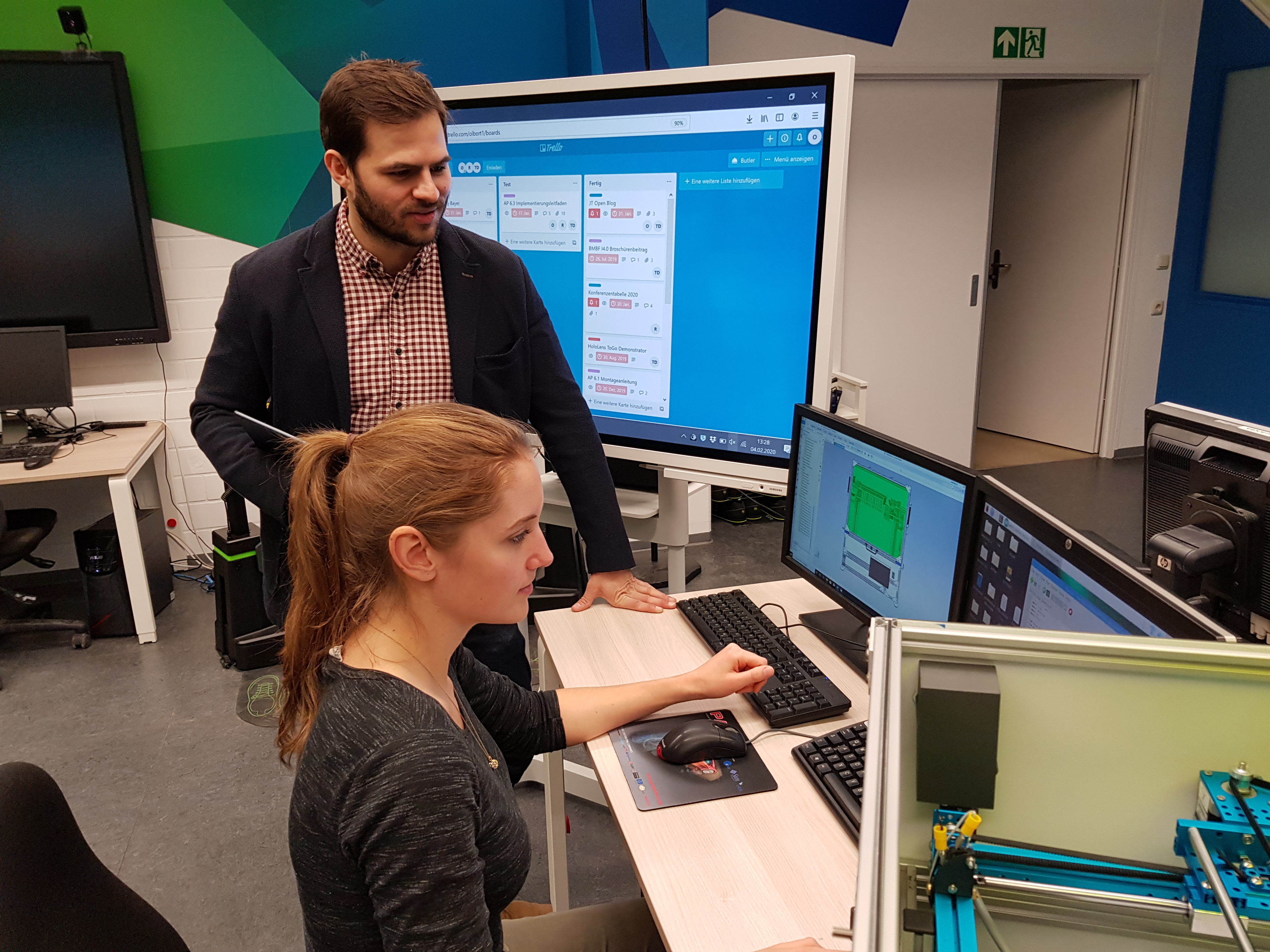Advanced Systems Engineering für die Arbeitsgestaltung von Cyber-technischen Systemen (CyberTech)
Stellen Sie sich Ihre individuelle Projektübersicht zusammen.
Schlagwort: Advanced Systems Engineering
Fördermaßnahme: Beherrschung der Komplexität soziotechnischer Systeme - Ein Beitrag zum Advanced Systems Engineering für die Wertschöpfung von morgen (PDA_ASE)

Forschungsziel: Ziel des Forschungsprojekts CyberTech war die Erarbeitung von geeigneten, softwarebasierten Werkzeugen zur Informationsintegration im Entstehungsprozess von Maschinen und Anlagen. Dabei spielte die menschzentrierte Arbeitsgestaltung, basierend auf digitalisierten Prozessen und Methoden, eine maßgebliche Rolle innerhalb der Organisation von Unternehmen. Durch Schulungskonzepte und Gestaltungshinweise konnten Mitarbeitende unterstützt und Arbeitsabläufe optimiert werden. Die prototypische Umsetzung erfolgte durch den Aufbau sowie die virtuelle und physische Inbetriebnahme von Demonstratoren in der Medizintechnik. Durch die erarbeiteten sozio-technischen Methoden, Schulungskonzepte und Leitfäden kann die Komplexität zukünftiger Entwicklungsprozesse für selbstoptimierende Maschinen bzw. Dienste menschzentriert beherrscht werden. Die Erkenntnisse werden darüber hinaus in wissenschaftlichen Lehr- und Lernlaboren für die Aus- und Weiterbildung vor allem für KMU zugänglich gemacht.
Ansprechperson Projektkoordination
Dr. Sven Kleiner +49 6151 7376-133
sven.kleiner@em.ag
Ansprechperson bei PTKA
Dipl.-Ing. Stefan Scherr
+49 721 608-25286
stefan.scherr@kit.edu
Problemstellung
Die ausgeprägte, vernetze Entwicklungsarbeit über den gesamten Produktlebenszyklus und über Unternehmensgrenzen hinweg sowie eine an den Produktentstehungsprozess angepasste Arbeitsorganisation erfordern eine angepasste Herangehensweise. Beispielsweise verstärkt der vermehrte Einsatz von Sensorik in Maschinen und Anlagen die Komplexität des Produktentstehungsprozesses von neuartigen Maschinen und Anlagen zu cyber-physischen Systemen. Bei diesen stehen nicht nur die konstruktive Auslegung sowie Automatisierungstechnik im Fokus, sondern auch der zunehmende Austausch sowie die Analyse vorhandener und verteilter Daten, beispielsweise für eine vorausschauende Wartung und neuartige Dienstleistungskonzepte. Damit ein Zusammenspiel von Nutzern, Monteuren und Entwicklern reibungslos funktionieren kann, waren dazu geeignete Methoden und neue Schulungsmaßnahmen bereitzustellen.
Projektziel
Ziel des Forschungsprojekts CyberTech war die Erarbeitung von geeigneten, softwarebasierten Werkzeugen zur Informationsintegration im Entstehungsprozess von Maschinen und Anlagen. Dabei spielte die menschzentrierte Arbeitsgestaltung, basierend auf digitalisierten Prozessen und Methoden, eine maßgebliche Rolle innerhalb der Organisation von Unternehmen. Durch Schulungskonzepte und Gestaltungshinweise konnten Mitarbeitende unterstützt und Arbeitsabläufe optimiert werden.
Vorgehensweise
Dies erforderte eine systematische Analyse bereits bestehender Arbeitsumgebungen und die Ableitung von Gestaltungsmöglichkeiten am Beispiel der Medizintechnik. Einerseits wurden auf der organisatorischen Ebene, z. B. mittels agiler und interdisziplinärer Teams, neuartige Arbeitsformen entwickelt und erprobt. Andererseits wurden zur besseren Qualifizierung aller Beteiligten, beispielsweise Schulungsangebote im Bereich arbeitsorientiertes Lernen definiert und in Leitfäden erfasst. Mit Sensordaten aus der späteren Nutzungsphase wurde beispielsweise ein Digitaler Zwilling erzeugt, welcher zur weiterführenden Produktoptimierung verwendet wurde. Unter Verwendung von KI-Methoden wurden hierzu entsprechende Softwarebausteine entwickelt.
Ergebnisse und Anwendungspotenzial
Die prototypische Umsetzung erfolgte durch den Aufbau sowie die virtuelle und physische Inbetriebnahme von Demonstratoren für die Medizintechnik. Durch die erarbeiteten sozio-technischen Methoden, Schulungskonzepte und Leitfäden konnte die Komplexität zukünftiger Entwicklungsprozesse für selbstoptimierende Maschinen bzw. Dienste menschzentriert beherrscht werden. Die Erkenntnisse wurden darüber hinaus in wissenschaftlichen Lehr- und Lernlaboren für die Aus- und Weiterbildung vor allem KMU zugänglich gemacht. Zudem wurden die Ergebnisse über Verbände und Arbeitsgruppen verbreitet sowie für die Fachöffentlichkeit publiziert.
- :em engineering methods AG
- ESI Germany GmbH
- Mechatronic Medical Engineers GmbH
- SysDICE GmbH
- Technische Universität Darmstadt
- Woco Industrietechnik GmbH
Titel: CyberTech_system:ability 2024
Datum: 12-06-2024 09:00:48 - 13-06-2024 16:00:48
Ort: Stuttgart
Die technischen Systeme von morgen haben einiges drauf: Sie sind vernetzt, lernen eigenständig und agieren autonom. Und: Sie sind Schlüsselfaktor für eine nachhaltige Wirtschaft und Gesellschaft. Aber wie entwickeln Unternehmen diese Systeme erfolgreich und wettbewerbsfähig? Und wo kommt der Mensch ins Spiel? Die Antwort auf diese Frage liegt im Spannungsfeld zwischen Organisationsgestaltung, Technologie- und Methodenkompetenz. Die Konferenz system:ability ist Forum für Erfahrungsaustausch zwischen Wissenschaft und Wirtschaft mit Fokus auf dem Engineering in der intelligenten und nachhaltigen Produktentwicklung – von aktuellen Forschungsansätzen bis zu konkreten Lösungen aus der industriellen Praxis. Präsentiert werden insb. Ergebinisse aus der Förderrichtlinie "Advanced Systems Engineering" des BMBF. Vertreterinnen und Vertreter aus Wissenschaft und Industrie sind eingeladen, diese Fragen auf der zweitägigen Konferenz zu diskutieren. Die Konferenz bietet an beiden Tagen ein Programm aus Keynotes aus Industrie und Wissenschaft, Fachvorträgen und Workshops in parallelen themenbezogenen Sessions sowie eine begleitende Fachausstellung mit unterschiedlichste Exponaten.
Titel: CyberTech_Adcvanced Systems Engineering Summit 2024
Datum: 12-11-2024 09:00:18 - 13-11-2024 17:00:18
Ort: Stuttgart, Fraunhofer-IAO
Merken Sie sich den nächsten Advanced Systems Engineering Summit vor! Am 12. und 13.11.2024 lädt das Fraunhofer IAO Entwickler, Product Engineers und Entscheidungsträger aus Unternehmen ein, über aktuelle Entwicklungen und Trends im Engineering zu diskutieren: - Komplexitätsbeherrschung durch Advanced Systems Engineering (ASE) - Digitale Zwillinge in Entwicklung, Produktion und Nutzungsphase - Einsatz von Model-Based Systems Engineering für die digitale - Durchgängigkeit in der Produktentstehung - Modellbasierte Gestaltung nachhaltiger Systeme - Steigerung der Flexibilität durch Software-Defined-X - Stärkung der Transparenz durch intelligente Visualisierung und Wertstromanalysen - Künstliche Intelligenz (KI) in der Produktentwicklung Weitere Informationen folgen.
Ihre Favoriten
In der folgenden Liste sehen Sie Ihre ausgewählten Projekt-Favoriten.